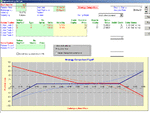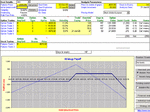If you find that you are wearing out the carpet between your screen and the toilet because that short you've just placed is going up, why not use options to play moves in the indices.
Here is a scenario that I worked out with the help of a talented mentor on 2nd Jan with the S&P at 1116, since when it has gone to 1131 and pulled back a bit.
The aim is to profit on an orderly pullback whilst hedging against an immediate spike up.
First put on a March 2 x1 short synthetic. i.e. Sell March 2 x 1150 calls for 15 and buy 1 x 1100 put for 27. (Red)
Then put on a January 2 x 2 long synthetic. i.e. sell January 2 x 1050 puts for 2.15 and buy 2 x 1150 calls for 2.05. (Blue)
The end result is shown on the payoff diagram below. The Jan options are shown in Blue and the March positions in Red. If the market spikes up above 1150 before the Jan expiry, you gain more or less $ for $ on the Jan long calls as you lose on the March short calls. If the market carries on rising after the Jan expiry then you have a loss situation if the S&P rises above the greater of 1150 or the Jan expiry AND IT KEEPS ON RISING.
Likewise, if the market tanks below 1050 before the Jan expiry (January short put strike), then you start to give back some of the profit accumulated in the March long puts, and probably show a loss below about 1010.
In the event of an orderly decline, which can go below 1050 after the Jan expiry (when the Blue strategy disappears), profit accumulates in the long March puts. And you still only have to worry if the market rises above 1150 before the March expiry, and there should be an opportunity to buy back the short March 1150 calls at less than you sold them for at some stage in the life of the strategy if they worry you because time-value decay is working in your favour.
So if you get the move, there is immediate profit. If it moves against you there is no problem below the higher of the Jan expiry or 1150, and no problem at any level between 1050 and 1150 before the Jan expiry. There is room to move, and sleep comes easily, and you avoid all the angst that you've been putting yourself through if you've stood in front of a rally and it's running you over. Just a thought!
Here is a scenario that I worked out with the help of a talented mentor on 2nd Jan with the S&P at 1116, since when it has gone to 1131 and pulled back a bit.
The aim is to profit on an orderly pullback whilst hedging against an immediate spike up.
First put on a March 2 x1 short synthetic. i.e. Sell March 2 x 1150 calls for 15 and buy 1 x 1100 put for 27. (Red)
Then put on a January 2 x 2 long synthetic. i.e. sell January 2 x 1050 puts for 2.15 and buy 2 x 1150 calls for 2.05. (Blue)
The end result is shown on the payoff diagram below. The Jan options are shown in Blue and the March positions in Red. If the market spikes up above 1150 before the Jan expiry, you gain more or less $ for $ on the Jan long calls as you lose on the March short calls. If the market carries on rising after the Jan expiry then you have a loss situation if the S&P rises above the greater of 1150 or the Jan expiry AND IT KEEPS ON RISING.
Likewise, if the market tanks below 1050 before the Jan expiry (January short put strike), then you start to give back some of the profit accumulated in the March long puts, and probably show a loss below about 1010.
In the event of an orderly decline, which can go below 1050 after the Jan expiry (when the Blue strategy disappears), profit accumulates in the long March puts. And you still only have to worry if the market rises above 1150 before the March expiry, and there should be an opportunity to buy back the short March 1150 calls at less than you sold them for at some stage in the life of the strategy if they worry you because time-value decay is working in your favour.
So if you get the move, there is immediate profit. If it moves against you there is no problem below the higher of the Jan expiry or 1150, and no problem at any level between 1050 and 1150 before the Jan expiry. There is room to move, and sleep comes easily, and you avoid all the angst that you've been putting yourself through if you've stood in front of a rally and it's running you over. Just a thought!



